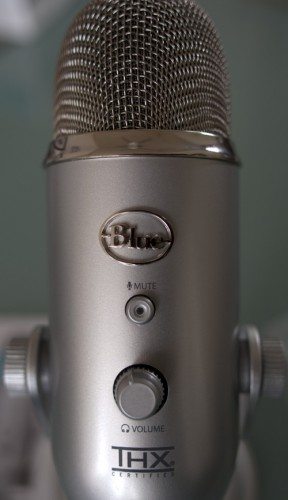 Blue Microphone has extended their USB microphone line to include the Yeti. The Yeti is a retro-looking microphone that has the flexibility to use four different recording patterns to adjust to your recording needs. These include:
Blue Microphone has extended their USB microphone line to include the Yeti. The Yeti is a retro-looking microphone that has the flexibility to use four different recording patterns to adjust to your recording needs. These include:
- Stereo
- Cardiod
- Omni
- Bidirectional
When Julie asked if anyone would be interested in reviewing this microphone, I became Horshack to her Mr. Kotter (and yes, I DID just make a mid-to-late ’70’s reference). My day job is instructional design which increasingly involves more and more e-learning projects. I have been looking for a USB mic, and this was definitely a contender.
Who is Blue?
Blue has a very good reputation with musicians. They have a very high-end line of microphones. Their tube-based Bottle microphone runs $6,000, so they should know quality microphones. Their USB line started with the Snowball microphone, a softball-sized USB mike that they claim was the first professional USB mic. They kept the theme with the smaller Snowflake microphone. So when they brought out the huge microphone I am reviewing here, they must have thought… “hmmm, it’s Big… kind of like the Abominable Snowman… I know… Yeti!”.
First Impressions
I really like the packaging. It is creative, entertaining, and very informative. The mike and stand come packed in a styrofoam, and they include a USB cable and a short manual.
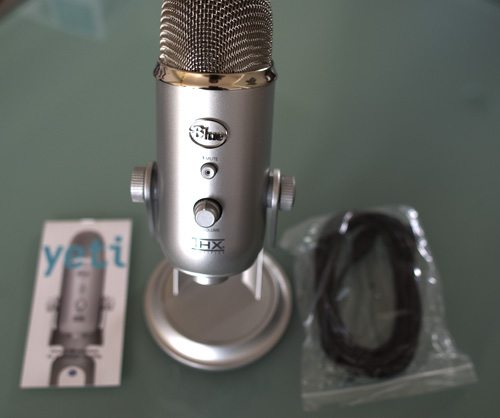
This microphone is big. And it is heavy. But I am not complaining. The weight feels comfortable to me, it feels very stable on the desktop. I really like the stand that it comes with, but if you need to, it has a standard threaded mic stand mount on the bottom between the micro-USB and headphone jack:
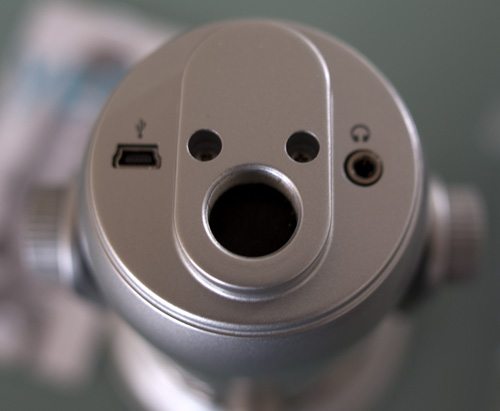
Setup
Setup is very simple. Plug the USB cable in the mic, plug the other end in the computer, then use. I tested on my MacBook Pro with Garageband with no issue. The mic is immediately recognized by name on the Mac.
Most of my work with this mic will involve Adobe Captivate, so my next task was to use it in Windows. Again, it shows up fine in Windows as a Blue Yeti mic (I run Windows in VMware Fusion). I will include a sample captivate demo at the end of this review.
Use
The controls on the microphone are pretty simple. The back of the microphone has a Gain dial to control how sensitive the mic is. There is also a 4-position dial to control the pattern the mic will use. From left-to-right you have Stereo, Omnidirectional, Cardioid, and Bidirectional.
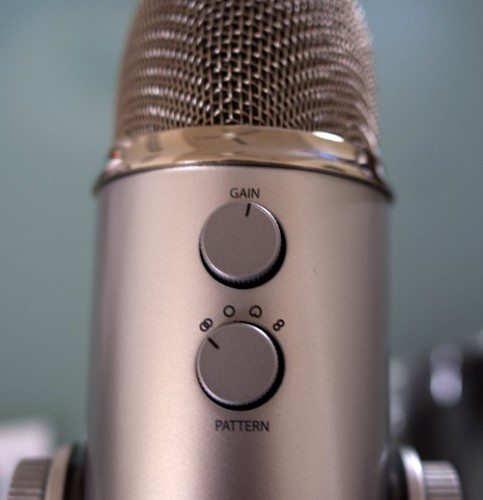
The front includes a mute button (it flashes red when mute is on, solid red when plugged in and ready to go) and a volume knob for the headphone jack.
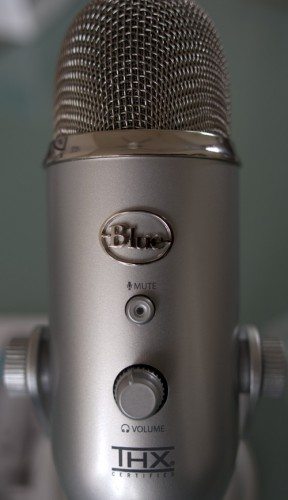
Performance
I was immediately impressed by the performance of the mic. The recordings I made on the Yeti were significantly better than the ones on the built-in mic (to be expected) and to other mics I have used in the past.
My only concern with reviewing this mic was my lack of professional experience (beyond voice-overs for e-learning). For that, I carted it up and visited a friend who is a first-rate musician named Tony Miracle. He is part of the band Venus Hum (who use a number of Blue Mics themselves) and releases solo projects under the names Satellite City and Tony Miracle.
I let him play with it a little bit, and he was able to do things with the Yeti I could only dream of. Obviously with his own home studio, he has better (and far more expensive equipment) but he was impressed by the capabilities.
The only performance issue I encountered at all was some occasional lag in the recording. This is due to the USB nature of the mic. Tony had expected it, and I have learned that most USB mics can experience lag, and it is dependent on your system. The only implication for me is I wait for a few beats after starting record to talk, and wait for a few beats after talking to stop the recording.
Demonstration
I wanted to give a demonstration of the Yeti in this review. To do this I went to the tools I use. And that is Captivate. Captivate lets me record audio, but keep in mind, this is no Pro Logic, the recording is for voice-overs. I did almost no work on the recordings. In the finger-picking example, I used a feature in Captivate to normalize volume since it was far softer than other recordings, but other than that it is unprocessed.
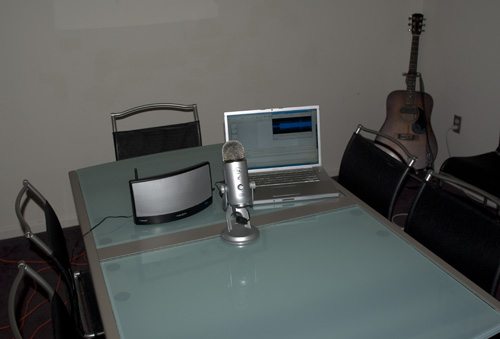
I kept the setup pretty basic. This was done in my living room, and I used my Tenqa SP-109 speakers as an audio source for the pattern demonstrations. Tony Miracle graciously allowed me to use a cut (Song for Charley Harper) from his album Cincinnati Modern to provide a consistent sound. SO the setup was:
- Yeti Microphone
- MacBook Pro
- Adobe Captivate
- VMWare Fusion
- Tenqa SP-109 bluetooth speakers
- T-Mobile G1 phone to play music
- Alvarez Yairi Guitar
Disclaimer
I did not spend any time tweaking the audio, beyond the normalize feature on the finger-picking section. I wanted to give as raw a look at the mic as possible. I am sure I will learn a lot how to further enhance the recordings later, but this review focuses on the mic. I also did not spend a lot of time scripting it out. I hope this helps give you a better picture of the microphone’s capabilities.
Conclusions
For some, the size of the Yeti might be a con. It has a big footprint, but I like how stable it is. It is a USB-only mic, so you won’t be using it without a computer, but it is a very nice USB microphone. I won’t be exploring other options for my microphone needs, this fills it very nicely.
DJI Mic Mini (2 TX + 1 RX + Charging Case), Wireless Lavalier Microphone for iPhone/Camera/Android, Ultralight, Detail-Rich Audio, 48h Use, Noise Cancelling, Automatic Limiting, Vlog, Streaming
53% OffFIFINE USB/XLR Dynamic Microphone for Podcast Recording, PC Computer Gaming Streaming Mic with RGB Light, Mute Button, Headphones Jack, Desktop Stand, Vocal Mic for Singing YouTube-AmpliGame AM8
23% OffProduct Information
| Price: | 149.99 |
| Manufacturer: | Blue Microphones |
| Pros: |
|
| Cons: |
|

![Small but Mighty - The DJI Mic Mini lavalier microphone transmitter is small and ultralight, weighing only 10 g, [1] making it comfortable to wear, discreet, and aesthetically pleasing on-camera. Detail-Rich Sound - Mic Mini wireless microphones deli...](https://m.media-amazon.com/images/I/31KzYDU8pvL._SL160_.jpg)
![[Natural Audio Clarity] Operated with frequency response of 50Hz-16KHz, the podcasting XLR mic delivers balanced audio range, likely to resonate with your audience. Directional cardioid dynamic microphone corded will not exaggerate your voice, while ...](https://m.media-amazon.com/images/I/31vZkgLpKmL._SL160_.jpg)
Gadgeteer Comment Policy - Please read before commenting
Great review. I have had this mic for about a month now and absolutely love it. I agree that the flexibility offered by having the four selectable patterns is fantastic.
I managed to solve the lag issue by using the ASIO4All driver (www.asio4all.com). On Windows it reduces the lag to the point where it’s not noticeable, even when recording and monitoring live instruments. I don’t know of any Mac equivalent driver/software though.
It’s probably also worth mentioning that the Yeti’s headphone jack works in two ways. Normally it’s just a mic monitor, so you can listen to what you’re recording in real-time (as this audio signal never goes to the computer, you don’t encounter the USB lag issues mentioned above). Alternatively, you can use the Yeti as an audio out interface for your computer (just select it in your OS’s sound settings), and play all audio through the headphone port.
I agree that the size of the Yeti isn’t an issue – I like the feeling of stability it gives. However one negative I’ve found is that it doesn’t have an inbuilt pop filter, so that might be something to consider if you’re going to be leaning in close when recording. I bought one designed to clip onto a normal mic stand for about £9 ($14), and it fits securely onto one of the “arms” of the Yeti’s base and works like a charm.
Sorry for the aside, but this is odd. I was JUST thinking about Venus Hum the other day, since we’d seen them a few years back opening for Blue Man Group and I was siting in traffic wondering if they had any new tunes. I’m off to their site to see – thanks for the reminder Bryan!
I have a question. What is your gain in the preferences of your mac? All way up to 100% or how do you do it??
Unfortunately I plugged my brand new Yeti into my Mac running 10.6.4 – nothing, doesn’t detect any mic and doesn’t recognise it at all. Not working…
The audio quality of this mic is a huge improvement over my old mics, but I’ve had problems with the mic not being recognized at any USB port where it’s been plugged in before. And sometimes it spontaneously “stops being recognized” for no apparent reason.
I don’t know a permanent cure, but a workaround has been to unplug the mic and then go into the MyComputer/DeviceManager and “uninstall” the audio device called “USB Audio Device”. Then, when I plug the mic back in a USB port, it reinstalls it as if it were a new device. Then it works again. I’m using an XP machine.
Another workaround is to plug it into a USB port that has never been used for the mic before. That also causes a “new device” installation to proceed, but then it too becomes “poisoned” and I have to go through the above procedure to make that port work again.
Too bad I have to do this. Otherwise, this is a wonderful product.
stop talking about Venus Hum!! haha but your plugs did work. the playmobile video is nuts! also i strongly believe that
^^The Slapster^^ may be a band member…
hey could FluidDruid or anyone else show me how to get it working with asio4all to eliminate the lag.
thx